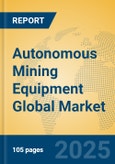Application Analysis
Metal
Autonomous equipment in metal mining, such as for iron ore, copper, and gold, grows at 9%-15% annually, driven by demand for high-value metals in industries like electronics and renewable energy. Trends include the use of AI-driven analytics to optimize ore extraction and reduce waste, with a focus on integrating renewable energy sources into equipment operations.Coal
Coal mining applications, growing at 7%-12% annually, leverage autonomous systems to enhance efficiency in declining but still significant coal markets. Trends emphasize retrofitting existing equipment with automation kits and remote operation systems to improve safety in high-risk environments.Mineral
Mineral mining, including phosphates and rare earth elements, grows at 8%-13% annually, driven by demand for critical minerals in technology and green energy sectors. Trends include autonomous drilling and hauling systems tailored for precision extraction in diverse geological conditions.By Type
Autonomous Mining/Hauling Trucks
Autonomous trucks dominate due to their role in large-scale material transport, growing at 9%-15% annually. Features like GPS-guided navigation and collision avoidance systems enhance efficiency. Trends include hybrid and electric trucks to reduce emissions, aligning with ESG goals.Autonomous Drilling Rigs
Drilling rigs, growing at 8%-14% annually, offer precision and reduced downtime through automation. Trends focus on AI-optimized drilling patterns and remote operation for hazardous sites.Underground LHD Loaders
Load-Haul-Dump (LHD) loaders for underground mining grow at 7%-13% annually, improving safety in confined spaces. Trends include sensor integration for real-time navigation and productivity monitoring.Tunneling Equipment
Tunneling equipment grows at 7%-12% annually, supporting underground mine development. Trends emphasize automation for complex geological environments and integration with digital twin technologies.Others
Other equipment, such as autonomous dozers and graders, grows at 6%-11% annually, with innovations in modular automation systems for smaller operations.Regional Market Distribution and Geographic Trends
North America: 8%-13% growth, led by the United States and Canada, where advanced mining operations and technology adoption drive demand. The U.S. focuses on autonomous trucks for metal mining, while Canada emphasizes minerals for clean energy.Asia-Pacific: 9%-15% growth, with Australia and China leading due to large-scale mining and government support for automation. India’s growing mineral sector boosts demand for cost-effective solutions.
Europe: 7%-12% growth, with Sweden and Finland prioritizing autonomous systems for sustainable mining under strict environmental regulations.
Latin America: 8%-14% growth, driven by Brazil and Chile’s metal mining sectors, particularly copper and lithium, with a focus on safety and efficiency.
Middle East & Africa: 7%-12% growth, with South Africa and Saudi Arabia adopting automation for mineral and metal extraction to enhance global competitiveness.
Key Market Players and Competitive Landscape
Caterpillar Inc. leads with autonomous trucks and retrofit solutions, emphasizing IoT integration for global mining operations. Komatsu Ltd. offers advanced autonomous hauling systems, popular in Asia-Pacific and Australia. Sandvik AB and Epiroc AB specialize in underground loaders and drilling rigs, with a strong European presence. Hitachi Construction Machinery Co. Ltd. provides tailored automation for metal mining, while Rio Tinto and Vale S.A. integrate autonomous systems into their operations, driving innovation. Aktiebolaget Volvo and Liebherr Group focus on sustainable equipment, with hybrid and electric options. Atlas Copco AB, Terex Corporation, and Metso Outotec offer niche solutions, while Zoomlion Heavy Industry, HD Hyundai Infracore, and Sany Heavy Industry Co. Ltd. cater to Asia-Pacific’s growing demand.Industry Value Chain Analysis
The value chain for Autonomous Mining Equipment is technology-intensive, spanning component manufacturing, system integration, and operational deployment, with significant value in automation and data analytics.Raw Materials and Upstream Supply
Raw materials include sensors, microchips, and durable alloys, sourced from electronics and metal suppliers. Companies like Caterpillar integrate with sustainable suppliers to ensure high-quality components, supporting reliability in harsh mining environments.Production and Processing
Manufacturing involves assembling equipment with embedded AI, sensors, and communication systems, requiring precision engineering. Producers like Komatsu invest in R&D for autonomous navigation and energy-efficient designs, adhering to safety and environmental standards.Distribution and Logistics
Distribution focuses on delivering heavy equipment and software updates to global mining sites, with logistics optimized for large-scale transport. Exports from North America, Europe, and Asia-Pacific ensure supply, with digital platforms supporting remote maintenance and upgrades.Downstream Processing and Application Integration
Metal/Coal/Mineral: Tailored for specific mining needs, enhancing efficiency.Trucks/Drills/Loaders: Integrated into mining workflows for productivity.
Downstream value lies in system integration with mine management software, reducing costs and improving safety through automation.
End-User Industries
Mining companies capture value through increased productivity, safety, and sustainability, with autonomous equipment enabling higher output and regulatory compliance.Market Opportunities and Challenges
Opportunities
Rising global demand for minerals, particularly for renewable energy, offers significant growth potential, especially in Asia-Pacific and Latin America. Advancements in AI and IoT enable smarter, more efficient equipment, while sustainability trends drive adoption of electric and hybrid systems. Government incentives for automation and partnerships with tech firms enhance market expansion, particularly for safety-focused solutions.Challenges
High initial costs and long ROI periods deter smaller operators, while regulatory variations across regions complicate deployment. Workforce retraining and resistance to automation pose challenges, alongside cybersecurity risks in connected systems. Supply chain disruptions for critical components like semiconductors and environmental concerns over equipment disposal require innovative solutions.This product will be delivered within 1-3 business days.
Table of Contents
Companies Mentioned
- Caterpillar Inc.
- Komatsu Ltd.
- Sandvik AB
- Epiroc AB
- Hitachi Construction Machinery Co. Ltd.
- Rio Tinto
- Vale S.A.
- Aktiebolaget Volvo
- Liebherr Group
- Atlas Copco AB
- Terex Corporation
- Zoomlion Heavy Industry Science & Technology Co. Ltd.
- HD Hyundai Infracore
- Sany Heavy Industry Co. Ltd.
- Metso Outotec








